Money
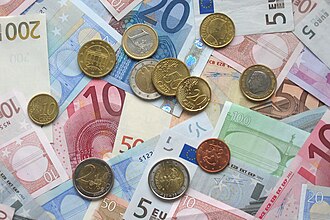
Money is any item or verifiable record that is generally accepted as
Money was historically an emergent market phenomenon that possessed intrinsic value as a commodity; nearly all contemporary money systems are based on unbacked fiat money without use value.[4] Its value is consequently derived by social convention, having been declared by a government or regulatory entity to be legal tender; that is, it must be accepted as a form of payment within the boundaries of the country, for "all debts, public and private", in the case of the United States dollar.
The
Etymology
The word money derives from the Latin word moneta with the meaning "coin" via French monnaie. The Latin word is believed to originate from a temple of
In the Western world a prevalent term for coin-money has been specie, stemming from Latin in specie, meaning "in kind".[6]
History

The use of barter-like methods may date back to at least 100,000 years ago, though there is no evidence of a society or economy that relied primarily on barter.[7][8] Instead, non-monetary societies operated largely along the principles of gift economy and debt.[9][10] When barter did in fact occur, it was usually between either complete strangers or potential enemies.[11]
Many cultures around the world eventually developed the use of
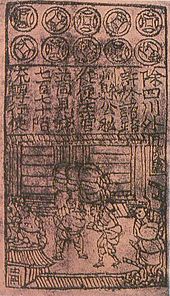
The system of
After
Functions
| Part of a series on |
| Macroeconomics |
|---|
 |
In Money and the Mechanism of Exchange (1875), William Stanley Jevons famously analyzed money in terms of four functions: a medium of exchange, a common measure of value (or unit of account), a standard of value (or standard of deferred payment), and a store of value. By 1919, Jevons's four functions of money were summarized in the couplet:
- Money's a matter of functions four,
- A Medium, a Measure, a Standard, a Store.[18]
This couplet would later become widely popular in macroeconomics textbooks.[19] Most modern textbooks now list only three functions, that of medium of exchange, unit of account, and store of value, not considering a standard of deferred payment as a distinguished function, but rather subsuming it in the others.[4][20][21]
There have been many historical disputes regarding the combination of money's functions, some arguing that they need more separation and that a single unit is insufficient to deal with them all. One of these arguments is that the role of money as a medium of exchange conflicts with its role as a store of value: its role as a store of value requires holding it without spending, whereas its role as a medium of exchange requires it to circulate.[22] Others argue that storing of value is just deferral of the exchange, but does not diminish the fact that money is a medium of exchange that can be transported both across space and time. The term "financial capital" is a more general and inclusive term for all liquid instruments, whether or not they are a uniformly recognized tender.
Medium of exchange
When money is used to intermediate the exchange of goods and services, it is performing a function as a medium of exchange. It thereby avoids the inefficiencies of a barter system, such as the inability to permanently ensure "coincidence of wants". For example, between two parties in a barter system, one party may not have or make the item that the other wants, indicating the non-existence of the coincidence of wants. Having a medium of exchange can alleviate this issue because the former can have the freedom to spend time on other items, instead of being burdened to only serve the needs of the latter. Meanwhile, the latter can use the medium of exchange to seek for a party that can provide them with the item they want.
Measure of value
A unit of account (in economics)[23] is a standard numerical monetary unit of measurement of the market value of goods, services, and other transactions. Also known as a "measure" or "standard" of relative worth and deferred payment, a unit of account is a necessary prerequisite for the formulation of commercial agreements that involve debt.
Money acts as a standard measure and a common denomination of trade. It is thus a basis for quoting and bargaining of prices. It is necessary for developing efficient accounting systems like double-entry bookkeeping.
Standard of deferred payment
While standard of deferred payment is distinguished by some texts,[22] particularly older ones, other texts subsume this under other functions.[4][20][21][clarification needed] A "standard of deferred payment" is an accepted way to settle a debt—a unit in which debts are denominated, and the status of money as legal tender, in those jurisdictions which have this concept, states that it may function for the discharge of debts. When debts are denominated in money, the real value of debts may change due to inflation and deflation, and for sovereign and international debts via debasement and devaluation.
Store of value
To act as a store of value, money must be able to be reliably saved, stored, and retrieved—and be predictably usable as a medium of exchange when it is retrieved. The value of the money must also remain stable over time. Some have argued that inflation, by reducing the value of money, diminishes the ability of the money to function as a store of value.[4][failed verification]
Properties
The functions of money are that it is a medium of exchange, a unit of account, and a store of value.[24] To fulfill these various functions, money must be:[25]
- Fungible: its individual units must be capable of mutual substitution (i.e., interchangeability).
- Durable: able to withstand repeated use.
- Divisible: divisible to small units.
- Portable: easily carried and transported.
- Acceptable: most people must accept the money as payment
- Scarce: its supply in circulation must be limited.[25]
Money supply
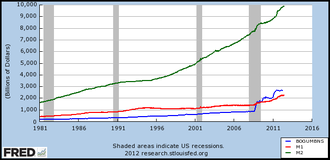
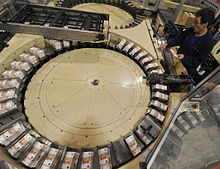
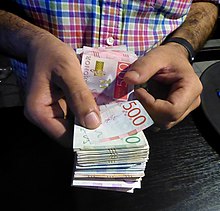
In economics, money is any financial instrument that can fulfill the functions of money (detailed above). These financial instruments together are collectively referred to as the money supply of an economy. In other words, the money supply is the number of financial instruments within a specific economy available for purchasing goods or services. Since the money supply consists of various financial instruments (usually currency, demand deposits, and various other types of deposits), the amount of money in an economy is measured by adding together these financial instruments creating a monetary aggregate.
Economists employ different ways to measure the stock of money or money supply, reflected in different types of monetary aggregates, using a categorization system that focuses on the liquidity of the financial instrument used as money. The most commonly used monetary aggregates (or types of money) are conventionally designated M1, M2, and M3. These are successively larger aggregate categories: M1 is currency (coins and bills) plus demand deposits (such as checking accounts); M2 is M1 plus savings accounts and time deposits under $100,000; M3 is M2 plus larger time deposits and similar institutional accounts. M1 includes only the most liquid financial instruments, and M3 relatively illiquid instruments. The precise definition of M1, M2, etc. may be different in different countries.
Another measure of money, M0, is also used. M0 is
Creation of money
In current economic systems, money is created by two procedures:[citation needed]
Legal tender, or narrow money (M0) is the cash created by a Central Bank by minting coins and printing banknotes.
Bank money, or broad money (M1/M2) is the money created by private banks through the recording of loans as deposits of borrowing clients, with partial support indicated by the cash ratio. Currently, bank money is created as electronic money.
Bank money, whose value exists on the books of financial institutions and can be converted into physical notes or used for cashless payment, forms by far the largest part of broad money in developed countries.[26][27][28]
In most countries, the majority of money is mostly created as M1/M2 by commercial banks making loans. Contrary to some popular misconceptions, banks do not act simply as intermediaries, lending out deposits that savers place with them, and do not depend on central bank money (M0) to create new loans and deposits.[29]
Market liquidity
"Market liquidity" describes how easily an item can be traded for another item, or into the common currency within an economy. Money is the most liquid asset because it is universally recognized and accepted as a common currency. In this way, money gives consumers the freedom to trade goods and services easily without having to barter.
Liquid financial instruments are easily
Types
Commodity

Many items have been used as
Representative
In 1875, the British economist
Fiat
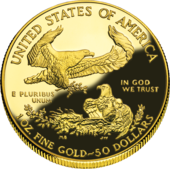
Fiat money or fiat currency is money whose value is not derived from any intrinsic value or guarantee that it can be converted into a valuable commodity (such as gold). Instead, it has value only by government order (fiat). Usually, the government declares the fiat currency (typically notes and coins from a central bank, such as the
Some
Fiat money, if physically represented in the form of currency (paper or coins), can be accidentally damaged or destroyed. However, fiat money has an advantage over representative or commodity money, in that the same laws that created the money can also define rules for its replacement in case of damage or destruction. For example, the U.S. government will replace mutilated Federal Reserve Notes (U.S. fiat money) if at least half of the physical note can be reconstructed, or if it can be otherwise proven to have been destroyed.[37] By contrast, commodity money that has been lost or destroyed cannot be recovered.
Coinage
These factors led to the shift of the store of value being the metal itself: at first silver, then both silver and gold, and at one point there was bronze as well. Now we have copper coins and other non-precious metals as coins. Metals were mined, weighed, and stamped into coins. This was to assure the individual taking the coin that he was getting a certain known weight of precious metal. Coins could be counterfeited, but they also created a new unit of account, which helped lead to banking. Archimedes' principle provided the next link: coins could now be easily tested for their fine weight of the metal, and thus the value of a coin could be determined, even if it had been shaved, debased or otherwise tampered with (see Numismatics).
In most major economies using coinage, copper, silver, and gold formed three tiers of coins. Gold coins were used for large purchases, payment of the military, and backing of state activities. Silver coins were used for midsized transactions, and as a unit of account for taxes, dues, contracts, and fealty, while copper coins represented the coinage of common transaction. This system had been used in ancient
Paper
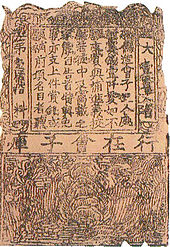
In

At around the same time in the
]In Europe, paper money was first introduced in
However, these advantages are held within their disadvantages. First, since a note has no intrinsic value, there was nothing to stop issuing authorities from printing more of it than they had specie to back it with. Second, because it increased the money supply, it increased inflationary pressures, a fact observed by
At this time both silver and gold were considered legal tender, and accepted by governments for taxes. However, the instability in the ratio between the two grew over the 19th century, with the increase both in the supply of these metals, particularly silver, and of trade. This is called bimetallism and the attempt to create a bimetallic standard where both gold and silver backed currency remained in circulation occupied the efforts of inflationists. Governments at this point could use currency as an instrument of policy, printing paper currency such as the United States greenback, to pay for military expenditures. They could also set the terms at which they would redeem notes for specie, by limiting the amount of purchase, or the minimum amount that could be redeemed.

By 1900, most of the industrializing nations were on some form of a gold standard, with paper notes and silver coins constituting the circulating medium. Private banks and governments across the world followed Gresham's law: keeping gold and silver paid but paying out in notes. This did not happen all around the world at the same time, but occurred sporadically, generally in times of war or financial crisis, beginning in the early part of the 20th century and continuing across the world until the late 20th century, when the regime of floating fiat currencies came into force. One of the last countries to break away from the gold standard was the United States in 1971.
No country anywhere in the world today has an enforceable gold standard or silver standard currency system.
Commercial bank
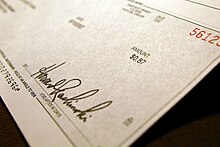
Commercial bank money or
Commercial bank money is created by commercial banks whose reserves (held as cash and other highly liquid assets) typically constitute only a fraction of their deposits, while the banks maintain an obligation to redeem all these deposits upon demand - a practise known as fractional-reserve banking.[41] Commercial bank money differs from commodity and fiat money in two ways: firstly it is non-physical, as its existence is only reflected in the account ledgers of banks and other financial institutions, and secondly, there is some element of risk that the claim will not be fulfilled if the financial institution becomes insolvent.
The
Digital or electronic
The development of computer technology in the second part of the twentieth century allowed money to be represented digitally. By 1990, in the United States all money transferred between its central bank and commercial banks was in electronic form. By the 2000s most money existed as digital currency in bank databases.[46] In 2012, by number of transaction, 20 to 58 percent of transactions were electronic (dependent on country).[47]
Anonymous digital currencies were developed in the early 2000s. Early examples include
Monetary policy
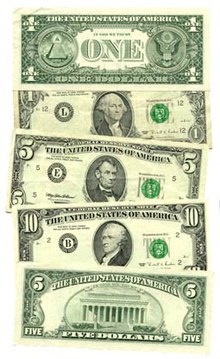
When gold and silver were used as money, the money supply could grow only if the supply of these metals was increased by mining. This rate of increase would accelerate during periods of
Modern-day monetary systems are based on fiat money and are no longer tied to the value of gold. The amount of money in the economy is influenced by
A failed monetary policy can have significant detrimental effects on an economy and the society that depends on it. These include
Monetary policy strategies have changed over time.[52] Some of the tools used to conduct contemporary monetary policy include:[53]
- changing the interest rate at which the central bank loans money to (or borrows money from) the commercial banks
- open market operations including currency purchases or sales
- forward guidance, i.e. publishing forecasts to communicate the likely future course of monetary policy
- raising or lowering bank reserve requirements
In the U.S., the Federal Reserve is responsible for conducting monetary policy, while in the eurozone the respective institution is the European Central Bank. Other central banks with a significant impact on global finances are the Bank of Japan, People's Bank of China and the Bank of England.
During the 1970s and 1980s monetary policy in several countries was influenced by an economic theory known as monetarism. Monetarism argued that management of the money supply should be the primary means of regulating economic activity. The stability of the demand for money prior to the 1980s was a key finding of Milton Friedman and Anna Schwartz[54] supported by the work of David Laidler,[55] and many others. It turned out, however, that maintaining a monetary policy strategy of targeting the money supply did not work very well: The relation between money growth and inflation was not as tight as expected by monetarist theory, and the short-run relation between the money supply and the interest rate, which is the chief instrument through which the cental bank can influence output and inflation, was unreliable. Both problems were due to unpredictable shifts in the demand for money. Consequently, starting in the early 1990s a fundamental reorientation took place in most major central banks, starting to target inflation directly instead of the money supply and using the interest rate as their main instrument.[56]
Locality
The definition of money says it is money only "in a particular country or socio-economic context". In general, communities only use a single measure of value, which can be identified in the prices of goods listed for sale. There might be multiple media of exchange, which can be observed by what is given to purchase goods ("medium of exchange"), etc. In most countries, the government acts to encourage a particular forms of money, such as requiring it for taxes and punishing fraud.
Some places do maintain two or more currencies, particularly in border towns or high-travel areas. Shops in these locations might list prices and accept payment in multiple currencies. Otherwise, foreign currency is treated as a financial asset in the local market. Foreign currency is commonly bought or sold on foreign exchange markets by travelers and traders.
Communities can change the money they use, which is known as
The money used by a community can change on a smaller scale. This can come through innovation, such as the adoption of cheques (checks). Gresham's law says that "bad money drives out good". That is, when buying a good, a person is more likely to pass on less-desirable items that qualify as "money" and hold on to more valuable ones. For example, coins with less silver in them (but which are still valid coins) are more likely to circulate in the community. This may effectively change the money used by a community.
The money used by a community does not have to be a currency issued by a government. A famous example of community adopting a new form of money is prisoners-of-war using cigarettes to trade.[57]
Financial crimes
Counterfeiting
Counterfeit money is imitation currency produced without the legal sanction of the state or government. Producing or using counterfeit money is a form of fraud or forgery. Counterfeiting is almost as old as money itself. Plated copies (known as
Money laundering
Money laundering is the process in which the proceeds of crime are transformed into ostensibly legitimate money or other assets. However, in several legal and regulatory systems the term money laundering has become conflated with other forms of financial crime, and sometimes used more generally to include misuse of the financial system (involving things such as securities, digital currencies, credit cards, and traditional currency), including terrorism financing, tax evasion, and evading of international sanctions.
See also
- Calculation in kind
- Coin of account
- Commons-based peer production
- Counterfeit money
- Digital currency
- Finance
- Foreign exchange market
- Free Money Day
- Gift economy
- Intelligent banknote neutralisation system
- Labour voucher
- Leprosy colony money
- Local exchange trading system
- Monetary economics
- Money bag
- Money management
- Non-monetary economy
- Seigniorage
- Slang terms for money
- Social capital
- Universal basic income
- Velocity of Money
- World currency
References
- ISBN 978-0-321-42177-7.
- ^ What Is Money? Archived 2022-12-05 at the Wayback Machine By John N. Smithin. Retrieved July-17-09.
- ^ "money : The New Palgrave Dictionary of Economics". The New Palgrave Dictionary of Economics. Retrieved 18 December 2010.
- ^ ISBN 978-0-7167-6213-3.
- ISBN 0-385-49062-3
- ^ "Online Etymology Dictionary". etymonline.com. Retrieved 2009-04-20.
- ^ Mauss, Marcel. The Gift: The Form and Reason for Exchange in Archaic Societies. pp. 36–37.
- ^ "The Myth of the Myth of the Myth of Barter and the Return of the Armchair Ethnologists". Bella Caledonia. 2016-06-08. Retrieved 2020-02-12.
- ^ "What is Debt? – An Interview with Economic Anthropologist David Graeber". Naked Capitalism. 2011-08-26.
- ^ David Graeber: Debt: The First 5000 Years, Melville 2011. Cf. review Archived 2020-04-20 at the Wayback Machine
- ISBN 978-0-312-24045-5. Retrieved 10 February 2011.
- ^ Kramer, History Begins at Sumer, pp. 52–55.
- ^ Herodotus. Histories, I, 94
- ^ Goldsborough, Reid (2003-10-02). "World's First Coin". rg.ancients.info. Retrieved 2009-04-20.
- ISBN 978-1-4363-0694-2.
- ^ Marco Polo (1818). The Travels of Marco Polo, a Venetian, in the Thirteenth Century: Being a Description, by that Early Traveller, of Remarkable Places and Things, in the Eastern Parts of the World. pp. 353–355. Retrieved 19 September 2012.
- ISBN 978-0230368897.
- ^ Milnes, Alfred (1919). The economic foundations of reconstruction. Macdonald and Evans. p. 55.
- ^ Dwivedi, DN (2005). Macroeconomics: Theory and Policy. Tata McGraw-Hill. p. 182.
- ^ a b Krugman, Paul & Wells, Robin, Economics, Worth Publishers, New York (2006)
- ^ ISBN 978-0-201-32789-2.
- ^ ISBN 1-890132-37-3
- ^ "Functions of Money". boundless.com. 2017-10-11. Archived from the original on October 18, 2015.
- ^ "What is Money?". International Monetary Fund. Retrieved 28 December 2022.
- ^ a b "Money" (PDF). Federal Reserve Bank of Dallas. Retrieved 28 December 2022.
- ISBN 978-1-932857-26-9.
- ^ "History of Money". Zzaponline.com. Archived from the original on 24 February 2015. Retrieved 24 February 2015.
- ^ Bernstein, Peter, A Primer on Money and Banking, and Gold, Wiley, 2008 edition, pp. 29–39
- ^ "Money creation in the modern economy | Bank of England". www.bankofengland.co.uk. 14 March 2014. Retrieved 2018-01-14.
- Liberty Fund, Inc., 1981), trans. H. E. Batson. Ch.3 Part One: The Nature of Money, Chapter 3: The Various Kinds of Money, Section 3: Commodity Money, Credit Money, and Fiat Money, Paragraph 25.
- ^ randRefinery.com Archived 2013-07-22 at the Wayback Machine. Retrieved July-18-09.
- ^ a b usmiNT.gov Archived 2016-08-20 at the Wayback Machine. Retrieved July-18-09.
- ISBN 978-1-59605-260-4. Retrieved 2009-06-28.
- ^ Deardorff, Prof. Alan V. (2008). "Deardorff's Glossary of International Economics". Department of Economics, University of Michigan. Retrieved 2008-07-12.
- ^ Black, Henry Campbell (1910). A Law Dictionary Containing Definitions Of The Terms And Phrases Of American And English Jurisprudence, Ancient And Modern, p. 494. West Publishing Co. Black's Law Dictionary defines the word "fiat" to mean "a short order or warrant of a Judge or magistrate directing some act to be done; an authority issuing from some competent source for the doing of some legal act"
- ^ Tom Bethell (1980-02-04). "Crazy as a Gold Bug". New York. Vol. 13, no. 5. New York Media. p. 34. Retrieved July-18-09
- ^ Shredded & Mutilated: Mutilated Currency, Bureau of Engraving and Printing. Retrieved 2007-05-09.
- OCLC 440360743. Archived from the originalon May 23, 2009. Retrieved August 28, 2010.
- ^ S2CID 153962294.
- ISBN 978-0-13-063085-8.
- ISBN 978-1-319-26390-4
- ISBN 978-1-349-95121-5. Retrieved 19 October 2023.
- ^ Ihrig, Jane; Weinbach, Gretchen C.; Wolla, Scott A. (September 2021). "Teaching the Linkage Between Banks and the Fed: R.I.P. Money Multiplier". research.stlouisfed.org. Federal Reserve Bank of St. Louis. Retrieved 2 November 2023.
- ^ McLeay, Michael; Radia, Amar; Thomas, Ryland (14 March 2014). "Money creation in the modern economy". Bank of England. Archived from the original on 2019-11-12. Retrieved 2019-11-14.
- ^ "The role of banks, non- banks and the central bank in the money creation process" (PDF). Deutsche Bundesbank. Monthly Report April 2017/13. Archived (PDF) from the original on 2019-09-17. Retrieved 2019-11-16.
- ^ "How Currency Works". 2 September 2003. Archived from the original on 30 July 2019. Retrieved 22 October 2018.
- ^ Eveleth, Rose. "The truth about the death of cash".
- ^ Wallace, Benjamin (23 November 2011). "The Rise and Fall of Bitcoin". Wired. Archived from the original on 31 October 2013. Retrieved 13 October 2012.
- ^ Jahan, Sarwat. "Inflation Targeting: Holding the Line". International Monetary Funds, Finance & Development. Retrieved 28 December 2014.
- ISBN 979-8-4002-3526-9. Retrieved 12 August 2023.
- ^ The Federal Reserve. 'Monetary Policy and the Economy". Archived 2007-06-20 at the Wayback Machine (PDF) Board of Governors of the Federal Reserve System, (2005-07-05). Retrieved 2007-05-15.
- ^ "Federal Reserve Board - Historical Approaches to Monetary Policy". Board of Governors of the Federal Reserve System. 8 March 2018. Retrieved 2 November 2023.
- ^ Baker, Nick; Rafter, Sally (16 June 2022). "An International Perspective on Monetary Policy Implementation Systems | Bulletin – June 2022". Reserve Bank of Australia. Retrieved 2 November 2023.
- ISBN 978-0-691-00354-2.
- ISBN 978-1-85898-596-1.
- ISBN 978-0-134-89789-9.
- JSTOR 2550133.
- ^ "A Case for the World's Oldest Coin". Retrieved 29 January 2013.
- S2CID 169545752.
- ^ "Counterfeiting statistics for several currencies". Itsamoneything.com. 2012-06-09. Retrieved 2014-09-21.
Further reading
- Chown, John F. A History of Money: from AD 800 (Psychology Press, 1994).
- Davies, Glyn, and Duncan Connors. A History of Money (4th ed. U of Wales Press, 2016) excerpt .
- Ferguson, Niall. The Ascent of Money: A Financial History of the World (2009) excerpt
- Forbes
- Kuroda, Akinobu. A Global History of Money (Routledge, 2020). excerpt
- Hartman, Mitchell (October 30, 2017). "How Much Money Is There in the World?". I've Always Wondered... (story series). Marketplace. American Public Media. Retrieved October 31, 2017.
- Lanchester, John, "The Invention of Money: How the heresies of two bankers became the basis of our modern economy", The New Yorker, 5 & 12 August 2019, pp. 28–31.
- Weatherford, Jack. The history of money (2009). by a cultural anthropologist. excerpt
External links
 Media related to Money (category) at Wikimedia Commons
Media related to Money (category) at Wikimedia Commons Quotations related to Money at Wikiquote
Quotations related to Money at Wikiquote The dictionary definition of money at Wiktionary
The dictionary definition of money at Wiktionary Works related to Money at Wikisource
Works related to Money at Wikisource- "Money", BBC Radio 4 discussion with Niall Ferguson, Richard J. Evans and Jane Humphries (In Our Time, Mar. 1, 2001)
- Bastable, Charles Francis (1911). . Encyclopædia Britannica. Vol. 18 (11th ed.). pp. 694–708.
